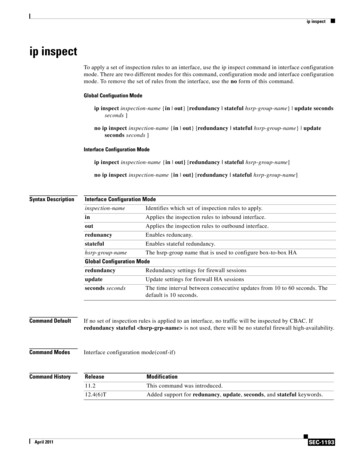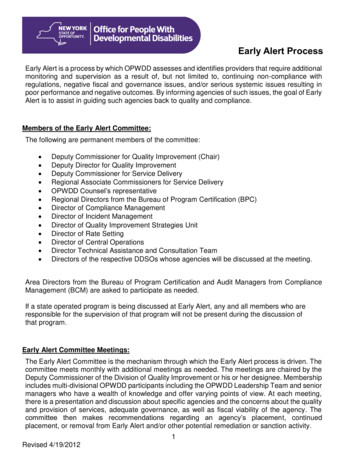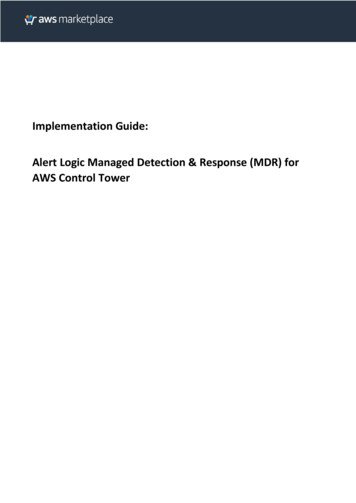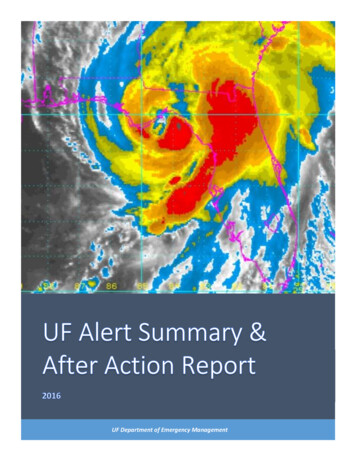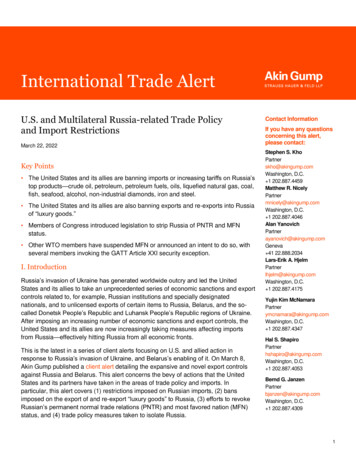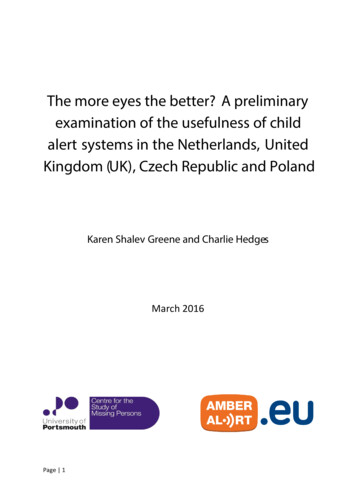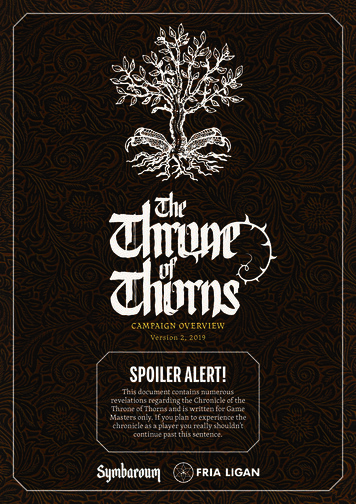
Transcription
CAMPAIGN OVERVIEWVersion 2, 2019SPOILER ALERT!This document contains numerousrevelations regarding the Chronicle of theThrone of Thorns and is written for GameMasters only. If you plan to experience thechronicle as a player you really shouldn’tcontinue past this sentence.
SPOILER ALERT!Again, this document contains numerousrevelations regarding the Chronicle of theThrone of Thorns and is written for GameMasters only. If you plan to experience thechronicle as a player you really shouldn’tcontinue past this sentence.2
THUS SPOKE AROALETA“ and at the dawn of days was Wyrhta, the power that creates.Where Nothing had reigned supreme, Wyrhta gave life to All;shaped here and there, spawned now and then,formed the one and in chorus the other.And where attraction arose,the wild thrived and multiplied but out of the untamed Wielda appeared, the power that rules:the power of willful violence, that bends here and there,that curves now and then according to ideals and cravings;that harvests the one and rejects the other.With time, Wielda’s appetite grew,and the birth was inevitable because violence begets hate begets Wratha, the power that reacts.Born of Wielda’s hunger for Wyrhta’s design, Wratha is everywhere and nowhere,always close where mother meets mother,always mounting in strength with the force of the violence.The arrival of the black fruit is fated,as inescapable as terrible and it happens, has happened, will happen again,that Wratha grows boundless, furious, blind in her hunger.It happens that the blackness grows flesh and spirit and the sharpest of claws,that the fruit sheds seeds that poison the first,in the aim to suppress the second.Then dies All ”The barbarian legend recounted above gives voice to anallegory describing the basic design of the world. The clanfolkshave borne witness to battles between the three principles ofthe legend, and have again and again been victimized by theaftereffects of such conflicts. Wyrhta represents Creation,Wielda the willful cultivation of Creation and Wratha thefurious force with which Creation reacts when cultivationextends into exploitation – a phenomenon known as Corruptionamong Ambrians.In reality, these principles have no names, no more thanthey are bound to some bodies or physical forms – they arenot gods. But the principles are none the less real, and overthe years countless individuals and creatures have acted astheir more or less distinct representations.The Chronicle of the Throne of Thorns is set in a time andplace where the power called Wielda is growing in strength,threatening to stir its age-old antagonist, Wratha, into action.What happens in Ambria and Davokar has happened before, inancient Symbaroum but also in the citystate Lindaros and inthe realm of the Dark Lords, once known as Lyastra. One whocan gaze even further back in time will find more examplesof regions where Wratha has been fed to the extent that itsrage has affected not only the agents Wielda but also Wyrhta’screation, resulting in widespread death and destruction.All episodes of the chronicle will touch upon what happensas Wielda (and thereby Wratha) mounts in strength, but it willtake some time before the player characters understand how tointerpret the signs. Even if a majority of the scenarios deal withsituations related to the grander scale of events, the playerswill most likely perceive them as being rooted in conflictsabout resources, knowledge or fame and glory – in short: inthe quest for power. It is only during the final episode that theywill realize what is at stake and are given an opportunity toinfluence the course of history.Another guideline when designing the chronicle has beenthat the episodes should be created as independent from eachother, meaning that the players will not have to play the samecharacters from start to finish, and also that each episode will3
have radical but local consequences. Regarding the latter, theindividual episodes will only have a marginal effect on thegame world at large, so that existing campaign material willnot become obsolete but may be of continued use after somesmall modifications.This text introduces the most important factions that areactive during the course of the chronicle’s adventures, andalso provides short descriptions of the episodes themselves.Our hope is that this will provide Game Masters with a basicunderstanding of the chronicle as a whole, so that you mayprepare gaming sessions and plan upcoming intermissionswith some knowledge of what is to come.ClarificationPlease understand that many book titles and names mentioned in this document are placeholders. Also, we hopeyou understand that some adjustments may be maderegarding the factions’ composition/strategies and thecontent of the episodes. This is simply unavoidable in aproject as massive as the Throne of Thorns.The FactionsThe Throne of thorns features an interesting mix of power ful factions. Aside from the ones described in this section,other organizations, groups and individuals will appear insingle episodes, but the ones listed below have a crucial roleto play in all or most of the adventures.A majority of the factions can be said to act in line withWielda, and it is the actions of these groups that propel thedeveloping events. Initially, they will also come off as themost powerful factions, but never forget that they are competing with each other, and also that their actions contributeto making the factions of Wratha grow stronger. Finally, itshould be noted that the Iron Pact and the Witches (in otherwords, the factions fighting for Wyrhta) have a defensive andreactive stance – their primary objective is to overthrow theplans of the others.Below, every important faction is described based the following characteristics:Role: The faction’s part in the story at large. Depending onwhat decisions the players make, this role may come to vary.Figureheads: Individuals/creatures who act as leaders ofthe faction, for a longer or shorter period of time. The leadersof smaller groupings within the faction take orders from andare accountable to the figureheads.Principle: States which principle is represented by theagents of the faction, in some cases more than one. Notethat defectors and infiltrators can be found within all majororganizations.Goal: The vision or dream that explains the actions of thefaction. However, single agents who appear in the episodescan be totally unaware of its faction’s “higher purpose” orhave goals of their own.Strength: That which speaks in favor of the faction andis its most important weapon in the competition with others.Weakness: That which speaks against the faction and is aliability that others can exploit.Relations: The overall relationship between the factionand other groupings – often closely tied to the principle itrepresents but not solely.House KohinoorRole: House Kohinoor and its representatives embody theambition to cultivate nature, to bring order to the wilds andto extract as much resources as possible from the world andits nature. As the story moves forward, Queen Korinthiawill evolve into a full-fledged representative of the principleknown as Wielda.Figureheads: Queen Korinthia is obviously the brightest shining star of House Kohinoor. Field Marshal BeremoHerengol is unswervingly loyal to the Queen and the army isdevoted to both of them. Ordo Magica’s Grand Master Seldonioshould also be counted among the figureheads, while otherThe Queen and the Field Marshal parading through Yndaros. Both are describedin the Core Rulebook, page 25 and 30.4
wizards may have more ambivalent feelings towards theQueen and her allies.Principle: House Kohinoor represents Wielda, regardWyrhta’s creation as a resource and Wratha as the sourceof evil.Goal: The ambition is that Ambria will grow so rich andpowerful that future enemies can quickly be vanquished, orpreferably deterred from attacking at all.Strength: The soldiers of Ambria idolize both the Queenand the Field Marshal, because of the victory over the DarkLords and all triumphant battles north of the Titans. Largeparts of Ordo Magica also stand firmly with the Queen,and, initially, the same can be said about an overwhelmingmajority of the Ambrian people. Even among those living inthe deepest misery, most of the discontent is aimed at othersthan House Kohinoor – at the Dark Lords who murderedAlberetor, but also at barbarians, rebels, elves and the wilddark of Davokar.Weakness: House Kohinoor displays few weaknesses, buttheir unwillingness to compromise and tendency to let the aimjustify the means make them prone to create enemies. Theschism found between the Queen and some of her relativesmust also be mentioned. Duke Alesaro may have the sameambitions as Korinthia, but naturally he wants to climb theAmbrian throne himself. Duke Ynedar, the Queen’s nephew,is also starting to grow a mind of his own. In time, Korinthia’spopularity will start to dwindle, mainly because of the aforementioned reasons. By the end of the fourth episode, she willhave turned large parts of the population against herself.Relations: Initially, House Kohinoor is officially allied withthe Priesthood and the Templars, but both these factions willdevelop into its enemies. It should also be mentioned that theQueen worries about First Father Jeseebegai’s ambitions rightfrom the start, and therefore secretly supports his adversarieswithin the Church – something she will come to regret beforethe end. The Witches’ faction will indeed never actively opposethe Queen; on the other hand, they will never count amongher loyal allies. The Iron Pact and the Sovereign’s Oath areand remain antagonists of House Kohinoor.The PriesthoodRole: During the course of the chronicle, the Sun Church willundergo a reformation. The interpretation of Prios championedby First Father Jeseebegai, according to which the god is namedthe Lawgiver, will be challenged by the Lifegiver – an older,gentler and more loving interpretation, emphasizing man’sresponsibility to care for and take care of Creation.Figureheads: Initially the Sun Church is governed bythe First Father and the spokesperson of the Twilight Friars,Brother Eumenos – two men of God with the same take onboth Prios’ commandments and the current state of Ambria.However, in the shadows the living Lightbringer Deseba theOld is working. Later in the chronicle she will orchestrate acoup (together with the Queen), leading to the imprisonmentof Jeseebegai and Sarvola’s elevation to First Father.Principle: At the start, the Priesthood represents Wielda;after the reformation they work more in line with Wyrhta.Goal: Jeseebegai’s goal is to turn Ambria into a theocracy ofthe Sun and to please Prios by driving the evil from Davokar.Following the reformation, the Sun Church and its agents willbecome a force fighting to put an end to mankind’s uninhibited exploitation, meaning that they will want to see a newKohinoor on the throne – namely the young Duke Ynedar.Strength: The Sun Church has its theurgs – a considerableforce in their own right. However, after the reformation, manytheurgs will be excommunicated since they refuse to acceptthe new interpretation of Prios’ commands. On the other hand,the faction will attract larger and larger parts of the Ambrianpopulation and can count on the support of many veteransfrom the Great War, convinced that Korinthia’s strategy is atrisk of reawakening the realm of the Dark Lords in Ambria.Weakness: The faction is suffering from a lack of warriors,especially when the Templars leave the Curia during the secondepisode. They are also plagued by internal struggles that tosome extent stop them from acting with full force.Relations: In the beginning, the Sun Church is officiallyallied to Korinthia, although the latter secretly conspireswith Deseba the Old. The Templars leave the Curia but willnot grow into enemies until after episode four – they leavethe Priesthood to gain greater independence for fighting evil,but will not become real antagonists until they lose all hopein humanity. And regarding the Iron Pact and most of thewitches, the trend is the opposite: they move from being thefactions appointed enemies to becoming its allies.The TemplarsRole: The Templars start off as fanatical combatants of Evil, inother words of the wilderness and its agents. Later they willreach the conclusion that Prios is dead and that the world isdescending into The Eternal Night. Thus, the Church of DeadPrios is founded, tasked to seek revenge on the murderers –elves, witches and heretical humans who from ignorance orgreed are responsible for the doom of the Lawgiver. Beforethe end, their beliefs are so profound and extreme that theyDeseba has served PriosAccording to Sar vola,since long before thethe only way to combatDark Lords’ aggressionsdarkness is to literally beturned her loving andthe Light. That said, it isn’tforgiving god into a cold,always easy even for himcondemning and ruthlessto think of the First Father,Giver of Laws.the Templars or murderousIron Pact members withlove and forgiveness.5
Leohan Mekele is theAlisabeta Vearra starts asTemplars most promi-the Templars’ leader onnent agent in the first twoKarvosti, then becomes aepisodes – one of threecommander in the Churchbrothers who have devotedof Dead Prios. Too young totheir lives to serving thehave experienced the GreatLawgiver with sword, shieldWar, she has instead pro-and burning devotion.ved her qualities in Ambria,many times over.willingly suffer corruption to serve their quest for vengeance.The Templars is the faction that “in the name of Light, wandersdeeper and deeper into the valley in the shadow of death”.Figureheads: The Knights of Prios are blindly loyal toCommander Iakobo Vearra. Later, his son Ervano and daughterAlisabeta take charge of one corps each, and as the chroniclecloses in on its grand finale they also join forces with thebonepale warriors of the night elf Gidim.Principle: The Knights of the Dying Sun start off as themost tenacious champions of Wielda but will eventuallyembark on the bloody road of revenge, thereby becominguncompromising agents of Wratha.Goal: At the start, the Templar’s aim is to save the dyingSun God by combatting His enemies, but as soon as the Churchof Dead Prios is founded, the goal changes into the quest forvengeance – first on the enemies, later on everybody, humansin particular.Strength: The Templars rely on their weapons and theirfaith. The faction’s cavalry is a force to be reckoned with andmany knights have “gifts from Prios” in the form of mysticalpowers. Close to the end they will also gain allies among otherswho regard humankind as the root of evil.Weakness: At the start of the chronicle, the faction includesabout two hundred Sun Knights and about as many followers(squires, laborers, stable hands and so on). Hence, the factionis not large in numbers and is also isolated from others becauseof their fanatical tendencies.Relations: Before Iakobo Vearra reaches the conclusionthat humankind must be eliminated, cooperation with factionslike House Kohinoor and the Priesthood is possible to somedegree. All other factions are right from the get-go paintedout as Prios’ murderers and therefore as deadly enemies tothe Sun Knights.The Sovereign’s OathRole: The Sovereign’s Oath is the ”threat in the north” thatgrows ever stronger with time.Figureheads: The obvious figurehead of the faction isthe Sovereign herself: the teenage girl who goes by no othername than the Blood-Daughter, and who is drenched in bloodwhenever she makes an appearance. However, the true leadersare her father, Clan Chieftain Razameaman of Saar-Kahn, andmaybe even more so the informal ruler of Gaoia, the lindwormOdralintos (Grandfather Lint).6
Principle: The Sovereign’s Oath is and remains a championof Wielda, like House Kohinoor.Goal: To reestablish Symbaroum with the Ambrians assubjugated slaves.Strength: The faction grows larger as more and more clansswear the oath. Its warriors are fearless, often pumped full ofpowerful elixirs, and the warlords can also make use of thespecial elite units of the subdued clans. Finally, Odralintosshould not be forgotten – with the help of the lindworm, thefaction can call other power hungry beasts of the forest to its aid.Weakness: The greatest weakness of the Sovereign’sOath is their lack of mystical powers – they ban all practiceof witchcraft at an early stage. Adding to that are the escalatingnumber of internal conflicts, caused by rebels within thesubdued clans.Relations: The Sovereign’s Oath is purely and simply at warwith everyone, even with the witches after having banned theuse of mystical powers.Even members of the clanscan sometimes be heardreferring to the HuldraYeleta as the true ruler ofDavokar. Read more abouther on page 26 in the CoreRulebook.The WitchesRole: In many situations the witches will stand out as likelyallies of the player characters, as they are desperately tryingto get both Ambrians and barbarians to understand their rolein the impending catastrophe.Figureheads: The Huldra Yeleta will not abandon her mission. From the tunnels of Karvosti and later on from whereshe is hiding in the wilds, it is she who dictates the wordsspoken by witches sent to advise the leaders of other factions.Her closest friends and helpers, Gadramon and Eferneya (seeimage above), often take the lead when there are more serioustasks to handle.Principle: The witches are convinced that a balancebetween Wyrhta and Wielda can be maintained – a convictionsupported by how the clans have lived and survived in Davokar.Goal: Most witches have taken it upon themselves to easethe effects of Wratha’s awakening; they want to put an end tothe rampage of the Ambrians and the Blood-Daughter, and alsodo what they can to keep Wratha dormant. When the latter isunsuccessful, the Huldra is quick to send witches to the sitetrying to limit the damage.Strength: The witches have their mystical powers, anunsurpassed local knowledge and can reach temporaryagreements with mighty beings who share their ambition tokeep Wratha asleep. In addition, when they are forced to leaveKarvosti, about halfway through the chronicle, they will beaccompanied by parts of the Wrath Guard.Weakness: Aside from being small in numbers, the witchesare divided between many different tasks. Some are alwaystraveling, hoping to talk sense into the leaders of other factions.The rest do their best to “quench fires” – that is, journey to7
Adreanea is not the mostunreasonable warrior ofthe Iron Pact, but not farfrom it. According to her,humankind is a diseasefrom which the world mustbe cured – by any and allmeans possible.locations where Wratha threatens to awake and prevent thatfrom happening; alternately try to sing the already awakenedaspect of Wratha back to sleep.Relations: The witches are the most neutral faction of all –they are no one’s enemy, yet no one’s friend. The exception is,of course, the groups fighting with the conviction of Wratha,yet even they are not regarded as pure enemies. Instead,Yeleta, as well as most of her followers, feels sorry for the“Tools of Wratha”.The Iron PactRole: During the chronicle, the Iron Pact will wage a desperate and ultimately hopeless battle ending in their nearannihilation.Figureheads: At the beginning, the Yndaros-based Eloriand Prince Eneáno in the Halls of a Thousand Tears areforemost among the Iron Pact members seeking a diplomaticsolution. The latter grows sicker and more erratic as timegoes by, and he ultimately meets his death during episodefour, in Symbar. Elori will then be exalted in his stead, anddeepen the already established collaborations with the SunChurch Reformists, especially Duke Ynedar, Father Sarvolaand Deseba the Old.Principle: The Iron Pact fights for Wyrhta, always inopposition to Wielda and Wratha.Goal: The elves and their allies want to put an end to humankind’s continuously growing dominance over, primarily,Davokar – through diplomacy or acts of violence.Strength: Aside from an unsurpassed knowledge abouthistorical events and Davokar’s nature, the pact memberspossess powerful magic and have warbands that are bothfleet-footed and accurate in their aim.Weakness: The members of the Iron Pact are too fewin numbers to wage an open war against the region’s otherfactions. They also have a hard time keeping up with eventsand acting in unison, primarily because elves in different lifestages tend to perceive the world very differently – that whichappears as an acute and serious problem to a summer elf mayto a winter elf seem like a gentle ripple on the ocean of time.Relations: It is hard to describe the faction’s relationsto other groupings in an unambiguous way, since the pactis made up of many divisions with different ideas when itcomes to goals and methods. Elori is one example showingthat the pact members can cooperate, and many witches cantestify about having friends among the elves. But basically,the members of the pact refuse to compromise in the defenseof Wyrhta’s creation and they have no sympathy for theagents of Wratha.Sacred of the Old BloodRole: The Sacred of the Old Blood is “the power in the shadows” who appears when one least expects it, using lies andmanipulation to make life difficult for everyone else. In time,the cult will become depraved and turn into one of Wratha’smost powerful tools.Figureheads: The cult was established by Duke Sesario, butthat fact is only known to his daughter, Duchess Esmerelda.She represents the duo when meeting with new recruits;recruits who during the first half of the chronicle neitherknow about each other’s identities or who their true leaderis. Other important individuals are Agramai Kalfas, knownas the Prince, and the lady-in-waiting Junia Dardall, whichboth have prominent roles to play in a couple of the episodes.Principle: Initially the Sacred of the Old Blood sides withWielda, but later on the followers and leaders will become moreand more corrupt, filling them with the desire to serve Wratha.Goal: Sesario and Esmerelda have two main aims – partlyto tame the dark powers of Davokar in order to ennoble thealready noble bloodlines of Ambria; partly to use this powerin order to restore the undead queen mother Abesina to life.Other members of the cult focus on the former, convinced thattheir fundamentally noble blood cannot be corrupted. But thatis, of course, erroneous and before the end the cult will haveas its main aim to wake Wratha – primarily by using lies anddeceit to seduce the members of other factions.Strength: The biggest strength of the cult is that it actsin secrecy and that the members have lots of contacts in, andaccess to, the halls of power. It should also be mentioned thatthey will grow more and more powerful as sorcerers – givingthem access to ever increasing numbers of undead warriorsand enslaved forest beasts.It may be difficult to believeAlready as a kid, Agramaithat Duchess EsmeraldaK a l f a s w a s t a u g h t to– loved and admired bycherish his noble bloodall – is the leader of one ofand regard his privilegesAmbria’s most callous andas godsent. The idea thatravenous blood cults.there exist forces of naturewhich are beyond the control of him and his peers isdownright ludicrous.8
Weakness: The cult’s greatest weakness, not least at thestart of the chronicle, is that its members primarily servetheir own self-interest. Up until the very end, the leaderduo will never be fully confident that their agents will dowhat they are told.Relations: At the start, none of the other factions knowof the cult’s existence. Near the end, they emerge from theshadows to become a powerful adversary to everyone else –most notably the Knights of Dead Prios who will regard “theSacred” as their main enemies.The Episodes of the ChronicleThis section aims to provide a general and concise descriptionof the chronicle as a whole. The portrayal of the episodes isbased on three main components: setting, theme and factions.Even if it may be considered self-evident, it should bementioned that all episodes leave it to the Game Master totweak, add, subtract and by other means adapt the adventuresto the preferences of his or her gaming group. Furthermore,all episodes will invite the players and their characters totake ownership of events, which in the end may mean thatdifferent gaming groups will play them in very different ways.You are of course welcome to bring any questions andthoughts inspired by this overview to debate on various socialforums. But please remember to offer fair warning, so that allthose who plan to experience the chronicle as players may do sowithout the burden of having “unwanted and vexatious insights”.The Composition of the EpisodesFirst a few words on the composition of the books in the series.Aside from the episodes of the adventure chronicle, each bookwill have two more sections. The idea is that all books will beginwith a segment meant to be read by both players and GameMasters, depicting the facade (or surface) of the main setting,such as it is appears to people in general – including noteworthyhistorical events, establishments, conflicts, individuals and soon. This way, the players (and their characters) can navigate thesetting and will have a greater capacity to take initiative and solveproblems without the Game Master guiding their steps. This partof the books will also be made available as standalone eBooks.After that comes a section exclusively meant for the GameMaster’s eyes, delving deep below the surface. Here you willlearn the truth behind the popular version of historical events,and get glimpses of what hides behind the counters, in thebackrooms and cellars of the setting’s establishments. Thesection also includes a long list of plot hooks for you to developinto adventures, and tools or guides on how to design differenttypes of scenarios. Finally, the Game Master’s section containsnew rules, powers, creatures, elixirs and so on – related to thefeatured adventure or to the main setting at large.The third section will be the adventure, and together thethree sections will number about 130–170 pages. So, that said,let us take a closer look at the adventures.Thistle Hold: Wrath of the WardenThe first episode of the Throne of Thorns will mainly be playedin Thistle Hold. A couple of detours into Davokar and down intothe Underworld will be made, but other than that the characterswill meet their challenges in the town of Mayor Nightpitch.The main theme of the adventure is about introducing theplayers and their characters to the basic conflicts of the gameworld; they are meant to get acquainted with the chronicle’smain factions, and learn a thing or two about their goals,methods and internal as well as external struggles. The questand its challenges deals with identifying and combatting acult of darkness worshippers which threaten to bring greatsuffering down on Thistle Hold and its residents. No matterif the characters act on their own initiative or are employed9
by a quest-giver, they will confront representatives fromHouse Kohinoor, the Iron Pact, the various divisions of theSun Church and so on.Yes, all factions will have agents or representatives inThistle Hold that the characters can encounter. The onlyexception is the Sacred of the Old Blood, whose agent in townis the root of the adventure’s plot but without stepping outfrom the shadows other than in the form of fleeting rumors.Karvosti: The Witch HammerThe second book focuses on the cliff of Karvosti and its surroundings. The player characters will enter the labyrinthinecaverns inside the rock, and will also travel to several siteslocated in the outer regions of the Forest of Davokar.The main theme of the adventure deals with the escalatingconflict between various Ambrian factions, especially betweenHouse Kohinoor and the Church of Prios. Another importanttheme is about establishing the importance of the legendarycity of Symbar and is equally mythical Throne of Thorns – atheme expressed in the adventure’s story, designed as thehunt for a person who claims to know where the lost capitalcity of Symbaroum can be found. The characters may becomeinvolved in the hunt for several reasons, and will learn a greatdeal about the history and structure of the ancient empire,including what finally made it crumble into ruin.Aside from the factions mentioned above, an Iron Pactwarband and a group of assassins from the Sovereign’s Oathwill feature in the adventure. The latter’s attempt to infiltratethe stronghold of the High Chieftain leads to the player characters’ (and the players’) first serious confrontation with thefollowers of the Blood-Daughter.Yndaros: The Darkest StarThe third episode of the chronicle is mainly set in Ambria’scapital Yndaros. Aside from adventures in the city and a tripto a noble estate in the Yndarian countryside, the playerRegarding Non-Player CharactersIn this campaign overview, as well as in the Core Rulebook and other supplements, you will read about non-player charactersliving in Symbaroum’s game world. Many of these (as for instance leading individuals within Ambria’s and Davokar’s factions)will appear in multiple campaign and adventure modules, but this should not stop you from using them when designing homebrew scenarios. They are meant to be put into play – to live, evolve and eventually meet a more or less epic demise.There is not only one version of Ambria, Davokar and their inhabitants; there are as many variants as there are groups of players. Of course, in the official publications, there is no way for us to take all possible variations into account, so in the end it is up toyou and your gaming group to make adjustments when called for. Should we, for instance, write about a person who has alreadydied in your version of the game world, you must simply replace it with someone else, possibly just by changing the name andappearance of the particular individual. The same is applicable if one or more persons have
4 have radical but local consequences. Regarding the latter, the individual episodes will only have a marginal effect on the game world at large, so that existing campaign material will not become obsolete but may be of continued use after some small modifications. This text introduces the most important factions that are

